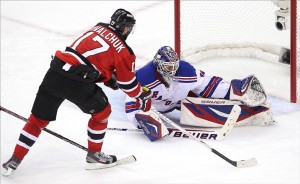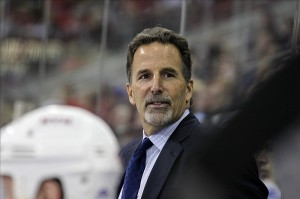The New York Rangers entered the 2012-2013 season with expectations as high as the Manhattan skyline. So, naturally, anything less than a scorching start raises questions regarding the Blueshirts’ play.
New York’s modest 8-6-2 record through the first third of the season puts them in the middle of the pack. However, for a team that recorded 109 points and reached hockey’s Final Four a season ago, being average is considered below average.
Here are a few reasons why the Rangers haven’t been able to replicate their success from last season:
The Lockout
Only six Rangers on the opening night roster played during the lockout, which was the fewest of any team in the NHL. With an abbreviated training camp, it was inconceivable for this year’s squad to be as well-conditioned compared to recent seasons.
In John Tortorella’s system, a high level conditioning is a prerequisite for having success. Without the top level of conditioning that the Blueshirts usually display, it’s difficult to execute the grinding style that won 51 games a season ago.
In addition, the lack of preseason games affected many players from getting into a rhythm. One of those players was the Rangers’ most valuable player in each of the last six seasons.

Henrik Lundqvist
In the Rangers season preview, one question entering the year was if the Blueshirts’ franchise goaltender could maintain his high level of play. While Lundqvist’s 2.29 goals against average and .918 save percentage are very good, they don’t match his 1.97 GAA and .930 save percentage from last year.
Frankly — since the Rangers’ 5-2 win over the Maple Leafs on January 26th — the 30-year-old has been the reason the Blueshirts have won the games where he was in net.
Even with high-profile offensive players, the Rangers win with defense and goaltending. “We’re not a run and gun team,” Tortorella said after the Blueshirts’ 2-1 victory over the Washington Capitals on February 17th.
“The staple of this club is to defend first and offense comes off of it.”
Without the benefit of preseason games, Lundqvist needed a few regular season games to find his groove. “Every year, I never feel good during the preseason,” Lundqvist said after an early season victory. “And usually, that’s three or four games.”
Since the Rangers 1-3-0 start (during which Lundqvist allowed 12 goals), they are 7-3-2 (and Lundqvist has only allowed 19 goals the 10 games he started).
Lack of Depth

This season — more than ever — Tortorella is riding his top players. After 16 games, seven Rangers are averaging over 20 minutes of ice time per game, and two others are a few seconds below that mark.
Even when Dan Girardi’s large amount of ice time was a topic of discussion a year ago, only five Blueshirts averaged more than 20 minutes a night during the regular season.
Up front, the Rangers sacrificed depth to acquire Rick Nash. And while that’s a move the Rangers would do again, Tortorella hasn’t seen enough from his role players to increase their ice time.
Chris Kreider has struggled to find his game, and if not for a recent undisclosed injury to Nash, he would probably be playing in the minors.
19-year-old J.T. Miller was recalled from the AHL’s Connecticut Whale in early February with the hope of igniting the offense. But after scoring his first two NHL goals in his second career game, Miller has only one point in his last six contests, and played just 9:42 in the Rangers’ 3-2 shootout loss to the Ottawa Senators.
Last night, the Blueshirts recalled Christian Thomas from the Whale in their search for more offense.
On the blueline, the Rangers’ sixth defenseman sees limited action. The three defensemen who have rotated in that role — Stu Bickel, Steve Eminger, and Matt Gilroy all average less than ten minutes of ice time per contest.
Finding Their Identity
The right way.
It’s a simple phrase that Tortorella uses to define the style of hockey that the Rangers play. The Blueshirts bench boss frequently talks about the mindset that the players need to have in order to be successful, and about establishing an identity.
The Rangers are still in search of that identity. The players that the Blueshirts brought in don’t have the same grittiness as the ones who left.
Based on the what the players have to say, the team as a whole needs to regain their identity — and their swagger — that led to their success.
Otherwise, an average start will result in an average finish.